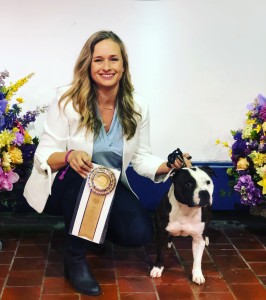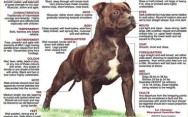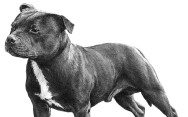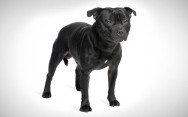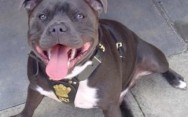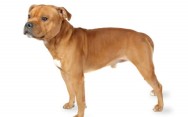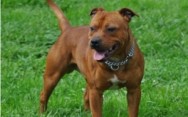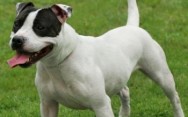About Staffordshire Bull Terriers Breed
This page is a work in progress… We plan to add a lot over time to help you be as informed as possible before deciding on a Stafford for your family. If you don’t see the answer you are looking for pleases feel free ton contact us with any questions. WE LOVE TALKING ABOUT STAFFORDS!
Most of the information below is from the Staffordshire Bull Terrier Club of America http://www.sbtca.com/
They have a wealth of information and interesting articles.
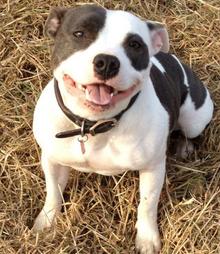
CHARACTERISTICS & TEMPERAMENT
Although individual differences in personality exist, there are some things that you can expect to find in the personality of every Stafford. They are tough, courageous, tenacious, stubborn, curious, people-loving and comfort-loving, protective, intelligent, active, quick and agile, and possess a strong “prey drive”. They are extremely “oral” youngsters and need a safe alternative to furniture, toys and clothing for their busy jaws. Staffords love to play tug-of-war and to roughhouse, but YOU must set the rules and YOU must be the boss. This is not a difficult task if you begin working with your Stafford when she is a puppy.
Most adult Staffords, particularly bitches, make excellent watchdogs; but in general they are inclined to protect people and not property. Their alert, muscle bound appearance is so striking that it’s easy to forget that they are smaller than most American Pit Bull Terriers. As Steve Eltinge in the book, The Staffordshire Bull Terrier in America says, “When a Stafford shows its teeth in a snarl, it can be frightening. They look tough and can be a positive deterrent to thieves, but because of their natural fondness for people, most Staffords are temperamentally ill-suited for guard or attack-dog training.” As with other members of the Bull and Terrier family, they can be the biggest people lovers in the world!
A Staffordshire Bull Terrier desires, more than anything else, to be with her people. Most adore a car ride, going on hikes and walks, enjoying a romp up the beach, and cozying up (or on) to you when you settle down for an evening of TV or reading.
Whatever the activity, “From the time it awakens in the morning until the quiet of night, a Stafford lives life to the fullest.” (Linda Barker, writing in The Staffordshire Bull Terrier in America, by Steve Eltinge).
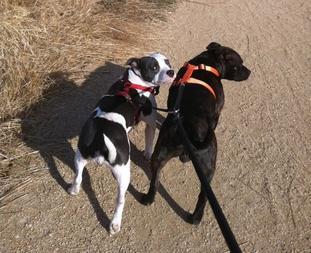
CARE AND TRAINING
Staffordshire Bull Terriers are a “natural” dog and generally robust. The short coat of this breed requires little grooming other than an occasional brushing and a bath. The downside of this drip dry coat is that Staffords are susceptible to fleas and ticks. The general remedies to discourage fleas and ticks are recommended, as well as a thorough going-over with a flea comb during the worse months of summer. Staffords covet human attention to the extent that I have seen several of them gather around their “person”, waiting to be combed from head to tail for fleas!
Care of nails, ears, teeth and anal glands are the same as they would be for any other breed (beginning when young and attention on a regular basis).
The Stafford is not a dog that tolerates weather extremes easily. Because of its short coat, it prefers plenty of shade and water on sweltering summer days (a child’s wading pool has been a popular choice in the past; supervised of course). Its Bulldog ancestry and brachycephalic (short-headed or broad-headed) respiratory system can contribute to overheating. Watch carefully to be sure that your Stafford doesn’t become overheated during intense play in the summer; if she appears to be wheezing or gasping for air, find the nearest source of cool – not ice cold – water and soak her to lower her body temperature.
Staffordshire Bull Terriers can boast a number of obedience and dogsport degrees and are “quick studies,” provided the trainer utilizes a positive, creative approach. Staffords are smart with a capital S. Young puppies enrolled in Kindergarten Puppy Training classes can begin to learn good habits and mix with other puppies. In addition to AKC obedience competition, Staffords have been successful Therapy Dogs, Canine Good Citizens, participated in Agility and Flyball Competitions and even “gone to ground” with other terriers!
Staffords are exuberant, impulsive, sometimes bull-headed … and surprisingly sensitive. A trainer must learn to be persistent, patient, and firm. Rome wasn’t built in a day and a great deal of ground may be lost in trying to adhere to the sort of inflexible techniques and rigid time frame advocated by some training books. Basic obedience training (at the very least) is a must for any Bull and Terrier. It helps to maintain control in unexpected situations. Because of their impulsive natures, the other cardinal rule of Bull and Terrier ownership is “always think ahead.” An ounce of prevention is worth a pound of cure! When it comes to strange – and especially aggressive – dogs, few Staffords are complete pacifists. Most will not back down if they are attacked or menaced, and some just don’t get along with strange dogs, period. This is a physically and mentally tenacious breed; be prepared!
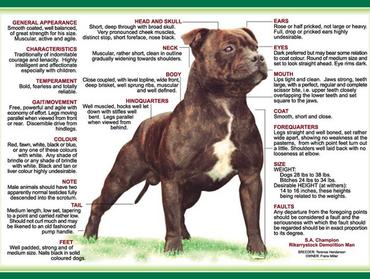
AKC Standard:
General Appearance
The Staffordshire Bull Terrier is a smooth-coated dog. It should be of great strength for its size and, although muscular, should be active and agile.
Size, Proportion, Substance
Height at shoulder: 14 to 16 inches. Weight: Dogs, 28 to 38 pounds; bitches, 24 to 34 pounds, these heights being related to weights. Non-conformity with these limits is a fault. In proportion, the length of back, from withers to tail set, is equal to the distance from withers to ground.
Head
Short, deep through, broad skull, very pronounced cheek muscles, distinct stop, short foreface, black nose. Pink (Dudley) nose to be considered a serious fault. Eyes–Dark preferable, but may bear some relation to coat color. Round, of medium size, and set to look straight ahead. Light eyes or pink eye rims to be considered a fault, except that where the coat surrounding the eye is white the eye rim may be pink. Ears–Rose or half-pricked and not large. Full drop or full prick to be considered a serious fault. Mouth–A bite in which the outer side of the lower incisors touches the inner side of the upper incisors. The lips should be tight and clean. The badly undershot or overshot bite is a serious fault.
Neck, Topline, Body
The neck is muscular, rather short, clean in outline and gradually widening toward the shoulders. The body is close coupled, with a level topline, wide front, deep brisket and well sprung ribs being rather light in the loins. The tail is undocked, of medium length, low set, tapering to a point and carried rather low. It should not curl much and may be likened to an old-fashioned pump handle. A tail that is too long or badly curled is a fault.
Forequarters
Legs straight and well boned, set rather far apart, without looseness at the shoulders and showing no weakness at the pasterns, from which point the feet turn out a little. Dewclaws on the forelegs may be removed. The feet should be well padded, strong and of medium size.
Hindquarters
The hindquarters should be well muscled, hocks let down with stifles well bent. Legs should be parallel when viewed from behind. Dewclaws, if any, on the hind legs are generally removed. Feet as in front.
Coat
Smooth, short and close to the skin, not to be trimmed or de-whiskered.
Color
Red, fawn, white, black or blue, or any of these colors with white. Any shade of brindle or any shade of brindle with white. Black-and-tan or liver color to be disqualified.
Gait
Free, powerful and agile with economy of effort. Legs moving parallel when viewed from front or rear. Discernible drive from hind legs.
Temperament
From the past history of the Staffordshire Bull Terrier, the modern dog draws its character of indomitable courage, high intelligence, and tenacity. This, coupled with its affection for its friends, and children in particular, its off-duty quietness and trustworthy stability, makes it a foremost all-purpose dog.
Disqualification
Black-and-tan or liver color.
Approved November 14, 1989
Effective January 1, 1990


